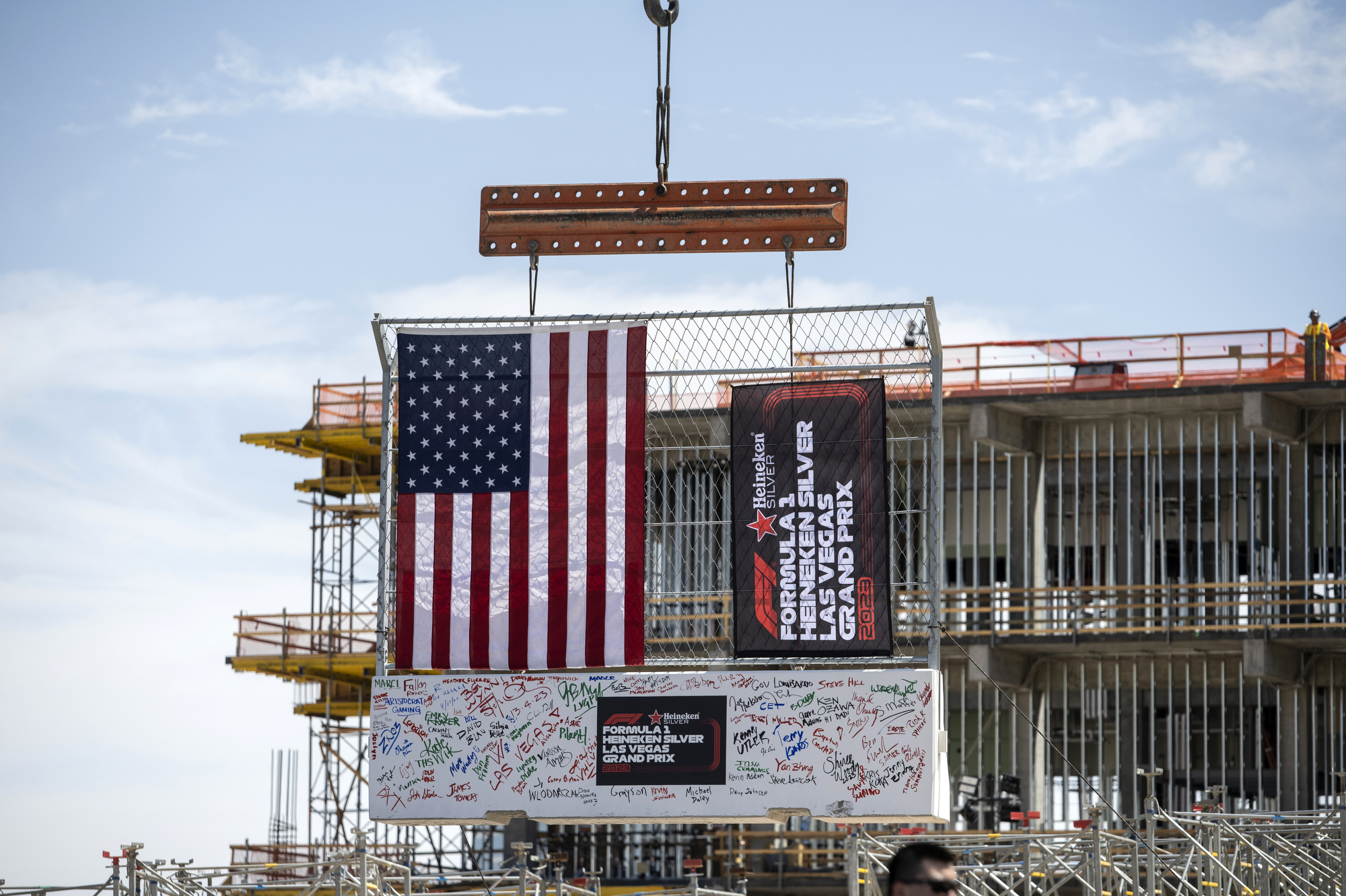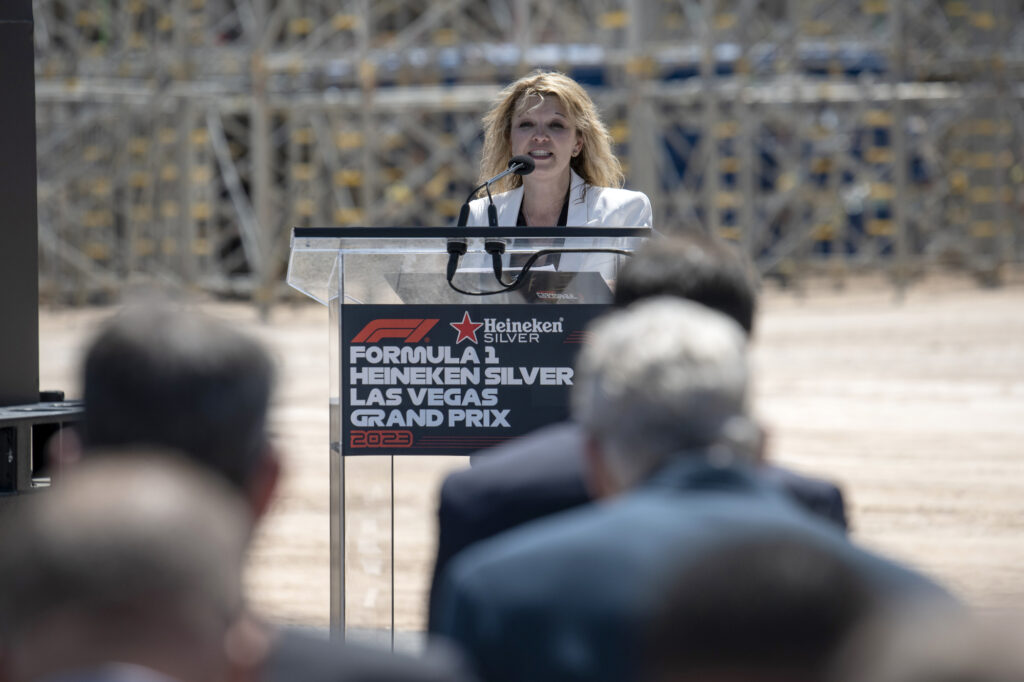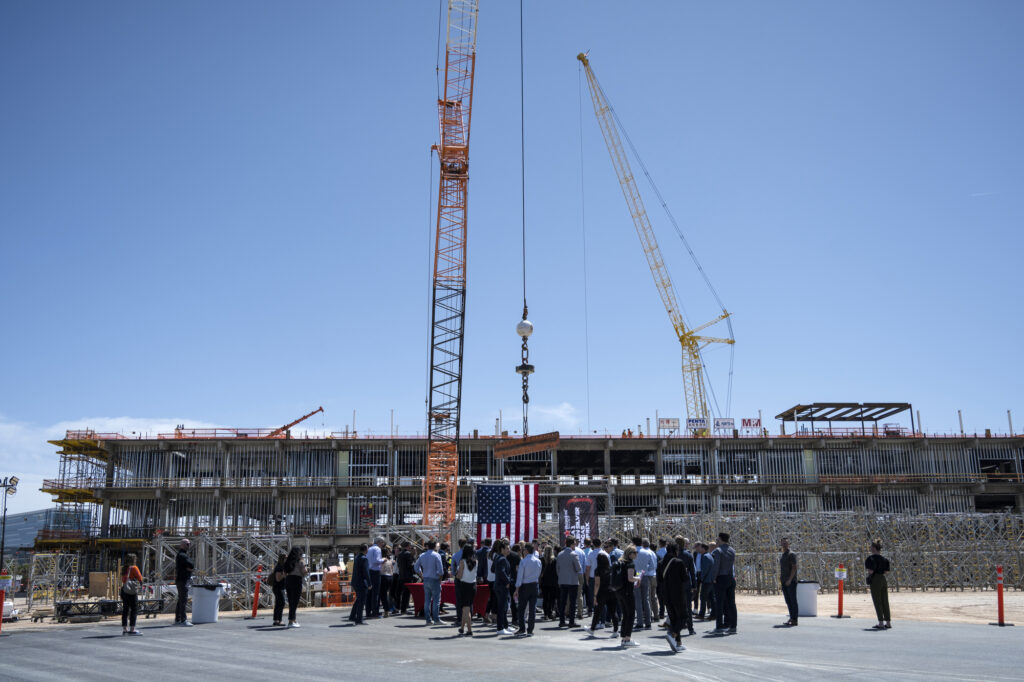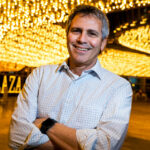$500M paddock building topped off 5 months ahead of Las Vegas’ F1 race weekend

Rather than lifting the typical last steel beam to signify a building’s topping-off, officials had something in mind that was more suitable for the $500 million paddock building that will be the focal point for Formula One’s Las Vegas Grand Prix.
“What is more appropriate for a Formula One race than a cement barrier,” Las Vegas Grand Prix CEO Renee Wilm said Thursday in an interview following the ceremony for the construction milestone.
Earlier, as construction crews raised “our take on the traditional beam” that was signed by F1 and Grand Prix officials, Gov. Joe Lombardo, Clark County commissioners, Las Vegas tourism executives and other dignitaries, Wilm noted the barrier would “live on the circuit footprint” during the race Nov. 16-18.
Construction on the paddock has been on its own high-speed race since last June when Liberty Media, the parent company of F1, spent $240 million to acquire the 39-acre site on the northeast corner of Harmon Avenue and Koval Lane.
The announcement that Las Vegas was awarded an F1 race came only three months earlier.
Las Vegas Grand Prix ticket sales began in the fall along with hotel room reservations, where Strip properties are seeing record-breaking rates as high as $1,800 a night. Special packages that include VIP seats, high-end suites and other amenities are being marketed for more than $1 million for the weekend.
A resurfacing project for portions of the Strip, Koval Lane, Harmon Avenue and Sands Avenue began in March and will last into September. Construction crews are adding new asphalt to the 3.8-mile, 14-turn racecourse.
The 300,000-square-foot, four-level paddock building is the central feature of the Las Vegas Grand Prix, with the race’s start-finish line and grandstands lining several locations along the track area. The ground floor includes the pit row and adjoining garages while the upper levels include high-end luxury suites and a rooftop area for race viewing.
Wilm said F1’s largest paddock club is currently in Monaco.
“It’s beautiful,” she said of the Monaco facility, “but tiny comparatively [to Las Vegas].”
Wilm said the facility will be used year-round and not just during race weekends. She said those details will come later, but noted some ideas are already falling into place.
“We’re looking to create exponential opportunities for the younger fans, for the families in town and for people who want to understand more about F1 and enjoy the thrill and the excitement of being a driver,” Wilm said. “That could be a racing school, it could be a convention center, it can be a restaurant opportunity. The sky's the limit right now and we're just beginning to scratch the beauty of Las Vegas for our viewers.”
Before the topping-off ceremony, Lombardo was given a tour of the paddock area by F1 and Las Vegas Grand Prix executives. Formula One CEO Stefano Domenicali called Lombardo, who took office in January, “Formula One’s newest fan.”
Lombardo found that remark amusing.
“I didn't realize I was the newest fan. I've actually been watching it on Netflix for a couple of years,” Lombardo said of the streaming service’s “Drive to Survive” documentary series on F1.
“As we look toward November, this is such an exciting time for Las Vegas and for all of Nevada,” Lombardo said. “This November, we get to take our commitment to professional sports to the next level when we welcome Formula One.”


Fast-paced construction
After acquiring the site, Liberty added $260 million to the budget and construction began quickly on the facility.
Wilm said the project would be completed by October, a month before the race. She said the construction is taking place 20 hours a day, but plans are in place to extend the location into a 24-hour building project.
“We fly in and out at night and it's incredible just to see everyone, the construction and everything moving so quickly,” Wilm said of the view she sees when the departure from nearby Harry Reid International Airport takes off over the venue’s site.
Liberty Media CEO Greg Maffei said Las Vegas “was the only place this could have gotten done in this timeframe.” Liberty acquired Formula One in 2016 and Maffei said the organization always considered Las Vegas as a U.S. location for the race, which is predominantly run in Europe, Asia, Australia and the Middle East.
The Las Vegas Grand Prix will join races in Austin, Texas, and Miami as the only U.S. stops on F1’s 23-race circuit.
“We certainly had an idea that there was an opportunity in the United States and Las Vegas would be the place,” Maffei said. “We had no idea that we would spend over $500 million and that we would still think it's a great opportunity despite having spent $500 million. It really is a case where everybody came together.”


Big numbers
In a presentation in January at the annual Preview Las Vegas, the business community’s annual economic showcase, Wilm said the race’s three events — practice runs, qualifying and the 190-mile, 50-lap race — will each attract more than 100,000 spectators daily. She said the economic impact for Las Vegas would be more than $1.2 billion.
“To give you some perspective on that number, [Las Vegas financial research firm] Applied Analysis conducted a similar study for the 2024 Super Bowl, which is projected to bring in approximately $600 million from that weekend’s event,” she said.
Wilm said Formula One and the Las Vegas Grand Prix are “contributing significantly” to the capital investment and startup costs.
“By race weekend, we will have created over 7,000 jobs for this community,” she said.
